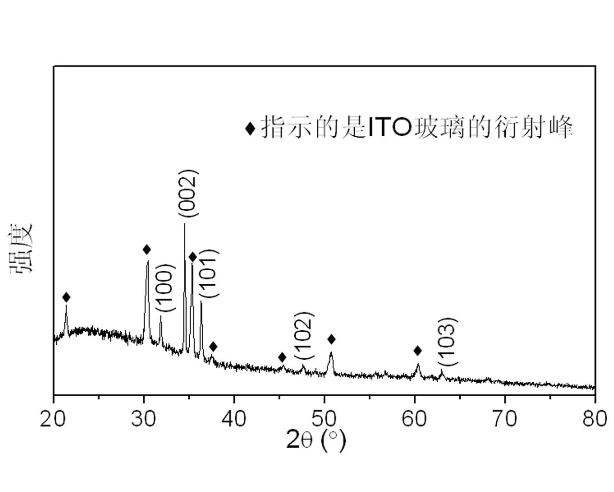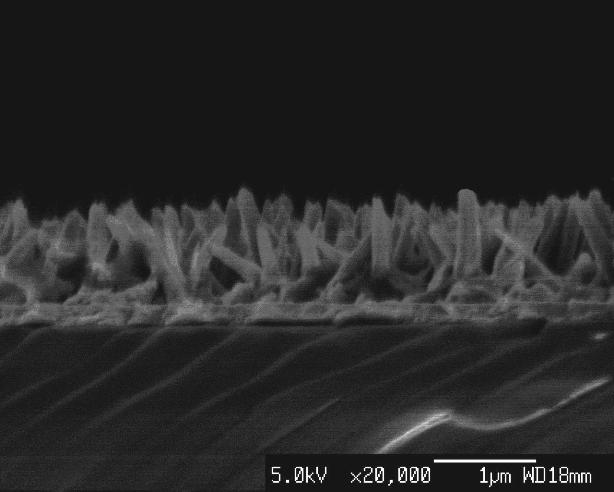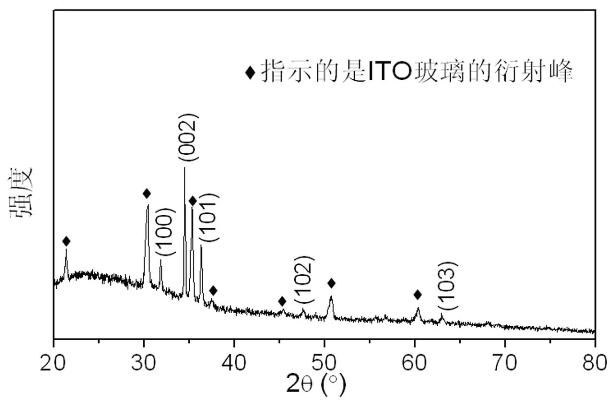Method for preparing ZnO nano-rod array through one-step electro-deposition
A nanorod array and electrodeposition technology, applied in chemical instruments and methods, electrolytic inorganic material coating, single crystal growth and other directions, can solve problems such as complex solution preparation, and achieve the effect of simple preparation and low cost
- Summary
- Abstract
- Description
- Claims
- Application Information
AI Technical Summary
Problems solved by technology
Method used
Image
Examples
Embodiment 1
[0018] Electrochemical deposition process at 0.01 mol / L Zn(NO 3 ) 2 Carried out in aqueous solution, the power source used is a two-electrode system, and the current density is constant at 0.1 mA cm -2 , the temperature was kept constant at 75 °C, and the deposition time was 30 min. The ITO glass substrate is connected to the cathode, and the anode uses a 2.25 cm 2 Platinum sheet, the two electrodes were kept parallel with a distance of 2 cm. After the deposition was completed, all samples were washed repeatedly with deionized water to remove residual solution ions on the samples. Afterwards, the samples were placed in a tubular heat treatment furnace for annealing at 150 °C. Heat treatment is carried out in the surrounding air atmosphere at 1.5 ℃ min -1 The heating rate was raised to the set temperature, kept for 6 h, and then heated at 1.5 °C min -1 Cool quickly to room temperature.
[0019] The color of the ZnO nanorod array is colorless and transparent by visual obs...
Embodiment 2
[0021] Electrochemical deposition process at 0.01 mol / L Zn(NO 3 ) 2 Carried out in aqueous solution, the power source used is a two-electrode system, and the current density is constant at 0.1 mA cm -2 , the temperature was kept constant at 85 °C, and the deposition time was 40 min. The ITO glass substrate is connected to the cathode, and the anode uses a 2.25 cm 2 Platinum sheet, the two electrodes were kept parallel with a distance of 2 cm. After the deposition was completed, all samples were washed repeatedly with deionized water to remove residual solution ions on the samples. Afterwards, the samples were placed in a tubular heat treatment furnace for annealing at 150 °C. Heat treatment is carried out in the surrounding air atmosphere at 1.5 ℃ min -1 The heating rate was raised to the set temperature, kept for 6 h, and then heated at 1.5 °C min -1 Cool quickly to room temperature.
[0022] The color of the ZnO nanorod array is colorless and transparent, and the crys...
Embodiment 3
[0024] Electrochemical deposition process at 0.05 mol / L Zn(NO 3 ) 2 It is carried out in aqueous solution, the power source used is a two-electrode system, and the current density is constant at 1 mA cm -2 , the temperature was kept constant at 95 °C, and the deposition time was 30 min. The ITO glass substrate is connected to the cathode, and the anode uses a 2.25 cm 2 Platinum sheet, the two electrodes were kept parallel with a distance of 2 cm. After the deposition was completed, all samples were washed repeatedly with deionized water to remove residual solution ions on the samples. Afterwards, the samples were placed in a tubular heat treatment furnace for annealing at 200 °C. Heat treatment is carried out in the surrounding air atmosphere at 1.5 ℃ min -1 The heating rate was raised to the set temperature, kept for 6 h, and then heated at 1.5 °C min -1 Cool quickly to room temperature.
[0025] The color of the ZnO nanorod array is colorless and transparent, and the ...
PUM
| Property | Measurement | Unit |
|---|---|---|
| diameter | aaaaa | aaaaa |
| diameter | aaaaa | aaaaa |
| length | aaaaa | aaaaa |
Abstract
Description
Claims
Application Information
 Login to View More
Login to View More - R&D
- Intellectual Property
- Life Sciences
- Materials
- Tech Scout
- Unparalleled Data Quality
- Higher Quality Content
- 60% Fewer Hallucinations
Browse by: Latest US Patents, China's latest patents, Technical Efficacy Thesaurus, Application Domain, Technology Topic, Popular Technical Reports.
© 2025 PatSnap. All rights reserved.Legal|Privacy policy|Modern Slavery Act Transparency Statement|Sitemap|About US| Contact US: help@patsnap.com



